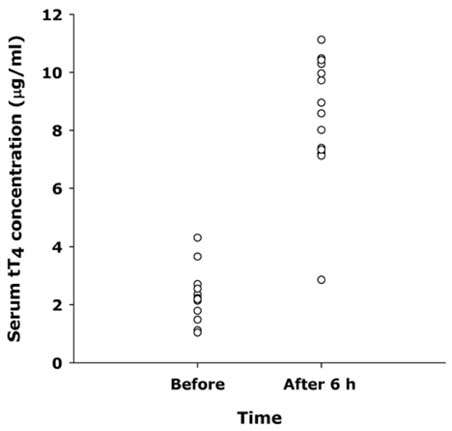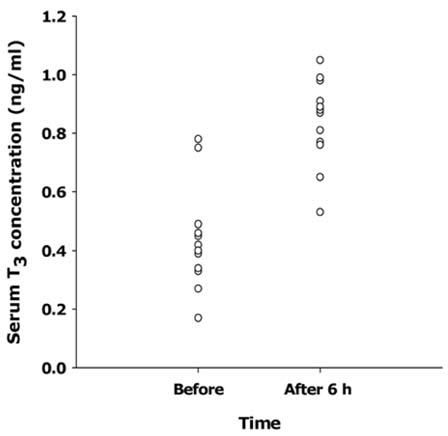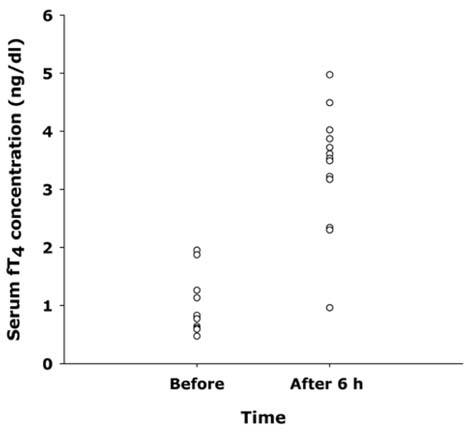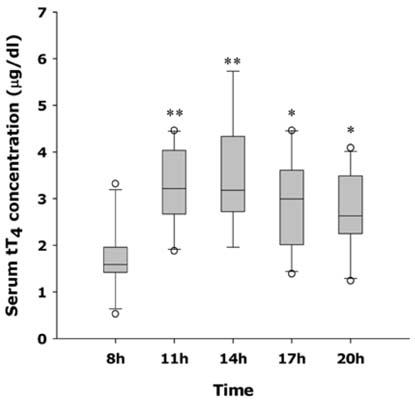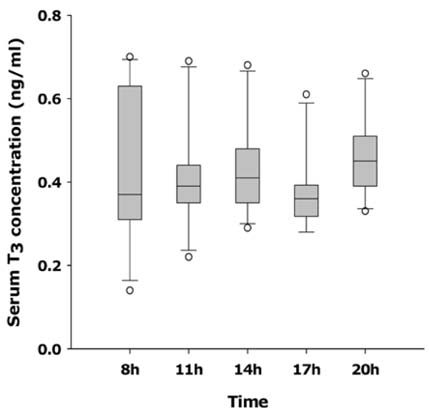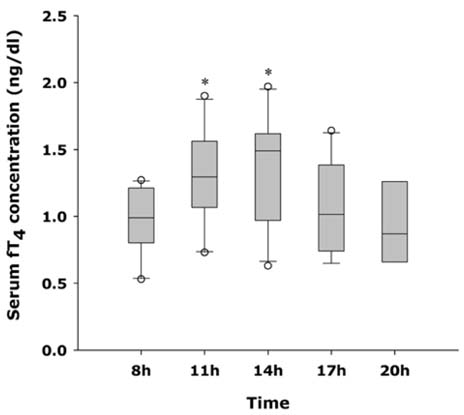J Vet Sci.
2006 Mar;7(1):25-29. 10.4142/jvs.2006.7.1.25.
Circadian variations of serum thyroxine, free thyroxine and 3,5,3'triiodothyronine concentrations in healthy dogs
- Affiliations
-
- 1Department of Veterinary Internal Medicine, College of Veterinary Medicine, Kyungpook National University, Daegu 702-701, Korea. thoh@knu.ac.kr
- KMID: 1103549
- DOI: http://doi.org/10.4142/jvs.2006.7.1.25
Abstract
- This study was to determine the daily fluctuation of serum thyroxine (tT4), free thyroxine (fT4), 3,5,3'-triiodothyronine (T3) concentrations in healthy dogs. Thyroid function of these dogs was evaluated on the basis of results of TSH response test. Samples for the measurement of serum tT4, fT4, and T3 concentrations were obtained at 3- hour intervals from 8 : 00 to 20 : 00. Serum tT4, fT4, and T3 concentrations were measured by the enzyme chemiluminescent immunoassay (ECLIA). Mean T3 concentrations had no significant differences according to the sample collection time during the day. Mean tT4 and fT4 concentrations at 11 : 00 were 3.28 +/- 0.86 microgram/dl and 1.30 +/- 0.37 ng/dl, respectively and mean tT4 and fT4 at 14:00 were 3.54 +/- 1.15 microgram/dl and 1.35 +/- 0.12 ng/dl, respectively. These concentrations were significantly high compared with tT4 and fT4 concentrations at 8:00, which were 1.75 +/- 0.75 microgram/dl and 0.97 +/- 0.25 ng/dl, respectively (p < 0.05). According to the sample collection time, mean tT4 and fT4 concentrations changed with similar fluctuation during the day. Based on these results, it was considered that measurement of serum tT4 and fT4 concentrations from 11 : 00 to 14 : 00 might more easily diagnose the canine hypothyroidism in practice.
Keyword
MeSH Terms
Figure
Reference
-
1. Damnet S, Ferguson DC. Influence of drugs on thyroid function in a dog. J Vet Intern Med. 2001. 15:539–546. 1.2. Dickson WM. Dukes HH, Swenson MJ, Reece WO, editors. Endocrine gland. Dukes' Physiology of Domestic Animals. 1993. 11th ed. Ithaca: Cornell University Press;640–645.3. Eiji O, Katsayoshi Y, Yoji U, Shigeyuki T, Takao S, Takuo I. Seasonal changes in serum total thyroxine, free thyroxine, and canine thyroid response hormone in clinically healthy beagles in Hokkaido. J Vet Med Sci. 2001. 63:1241–1243.4. Feldman EC, Nelson RW. Canine and Feline Endocrinology and Reproduction. 1987. 1st ed. Philadelphia: Saunders;55–85.5. Kantrowitz LB, Peterson ME, Trepanier LA. Serum total thyroxine, total triiodothyronine, free thyroxine, and thyrotropin concentrations in epileptic dogs treated with anticonvulsant. J Am Vet Med Assoc. 1999. 214:1804–1808.6. Kaptein EM, Hayes MT, Ferguson DC. Thyroid hormone metabolism: a comparative evaluation. Vet Clin North Am Small Anim Pract. 1994. 24:431–466.7. Kemppainen RJ, Behrend EN. Perspectives from a testing laboratory. Vet Clin North Am Small Anim Pract. 2001. 31:951–962.8. Laurberg P. Iodothyronine deiodination in the canine thyroid. Domest Anim Endocrinol. 1984. 1:1–27.
Article9. Laurberg P. T4 and T3 release from the perfused canine thyroid isolated in situ. Acta Endocrino. 1976. 83:105–113.
Article10. Miller AB, Nelson RW, Scott-Moncrieff JC, Neal L, Bottoms GD. Serial thyroid hormone concentrations in healthy euthyroid dog, dogs with hypothyroidism, and euthyroid dog with atopic dermatitis. Br Vet J. 1992. 148:451–458.
Article11. Nachreiner RF, Refsal KR. Radioimmunoassay monitoring with thyroid hormone concentrations in dogs on thyroid replacement therapy: 2674 cases (1985-1987). J Am Vet Med Assoc. 1992. 201:623–629.12. Nelson RW, Couto CG. Small Animal Internal Medicine. 1992. 2nd ed. St. Louis: Mosby;703–733.13. Nelson RW, Ihle SL, Feldman EC. Serum free thyroxine concentration in healthy dog, dogs with hypothyroidism, and euthyroid dogs with concurrent illness. J Am Vet Med Assoc. 1991. 198:1401–1407.14. Quadri SK, Palazzolo DL. How aging affects the canine endocrine system. Vet Med. 1991. 86:692–702.15. Refetoff S, Robin NI, Fang VS. Parameters of thyroid function in serum of 16 selected vertebrate species: a study of PBI, serum T4, free T4, and the pattern of T4 and T3 binding to serum proteins. Endocrinology. 1970. 86:793–805.
Article16. Reimers TJ, Lawler DF, Sutaria PM, Correa MT, Erb HN. Effects of age, sex, and body size on serum concentrations of thyroid and adrenocortical hormones in dogs. Am J Vet Res. 1990. 51:454–457.17. Reimers TJ, Mummery LK, McCann JP, Crown RG, Concannon PW. Effects of reproductive state on concentrations of thyroxine, 3,5,3'-triiodothyroine and cortisol concentration in serum of dogs. Biol Reprod. 1984. 59:658–665.18. Scott DW, Miller WH, Griffin CE. . Muller and Kirk's Small Animal Dermatology. 2001. 6th ed. Philadelphia: Saunders;780–789.19. Scott-Moncrieff JCR, Guptil-Yoran L. Ettinger SJ, Felman EC, editors. Hypothyroidism. Textbook of Veterinary Internal Medicine. 2005. 6th ed. Philadelphia: Saunders;1419–1429.
Article20. Singh AK, Jiang Y, Spassova D. Validation of nonradioactive chemiluminescent immunoassay methods for the analysis of thyroxine and cortisol in blood samples obtained from dogs, cats, and horses. J Vet Diagn Invest. 1997. 9:261–268.
Article21. Van Der Walt JA, Van Der Walt LA, Le Roux PH. Functional endocrine modification of the thyroid following ovariectomy in the canine. J S Afr Assoc. 1983. 54:225–229.
- Full Text Links
- Actions
-
Cited
- CITED
-
- Close
- Share
- Similar articles
-
- Leptin, adiponectin levels, and thyroid hormones in normal and obese dogs
- The Effect of Anesthesia ( Balanced anesthesia ) and Surgery on Thyroxine and Triiodothyronine Levels in Plasma
- Serum Cystatin C Concentrations in Patients with Graves’ Ophthalmopathy
- Changes of Thyroid Hormone during Open Heart Surgery
- A 3-year-old girl with Graves' disease with literature review

